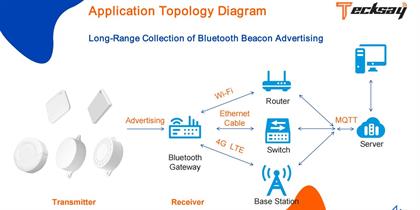
The BLE Link Layer: The Invisible Thread of Wireless Connectivity
September 21, 2024

In the realm of Bluetooth Low Energy (BLE) technology, the link layer stands as the silent sentinel, weaving the fabric of connectivity between devices. It is the unsung hero, operating behind the scenes to ensure seamless and efficient data exchange. This article delves into the intricacies of the BLE link layer, exploring its role, functionalities, and the pivotal part it plays in the BLE communication process.
The BLE Link Layer: A Foundation for Communication
The BLE link layer is a component of the Bluetooth protocol stack that operates between the physical layer and the higher-level host layers. It is responsible for managing the link between two BLE devices, ensuring reliable data transmission and reception. The link layer is akin to the foundation of a building, providing the necessary support for the structure above while remaining invisible to the naked eye.
Key Responsibilities of the BLE Link Layer
The BLE link layer has several key responsibilities that are crucial for the operation of BLE devices:
- Link Establishment: It handles the process of establishing a connection between two devices, including the exchange of connection parameters and the negotiation of link-specific settings.
- Data Transfer: The link layer manages the transmission and reception of data packets between devices, ensuring that data is sent and received correctly.
- Error Handling: It implements error detection and correction mechanisms to handle any discrepancies in data transmission, ensuring data integrity.
- Flow Control: The link layer regulates the flow of data to prevent one device from overwhelming another with data, maintaining a balanced communication stream.
- Security: It enforces security protocols to protect data during transmission, including encryption and authentication mechanisms.
The Role of Logical Link Control and Adaptation Protocol (L2CAP)
Within the BLE link layer, the Logical Link Control and Adaptation Protocol (L2CAP) plays a significant role. L2CAP provides a method for multiplexing multiple logical channels over a single physical link, allowing for the simultaneous transmission of different types of data. It also handles the segmentation and reassembly of data packets, ensuring that large data payloads can be effectively transmitted over the BLE link.
Channelization in BLE
BLE employs a channelization scheme that divides the 2.4 GHz ISM band into 40 channels. Three of these channels are used for advertising, while the remaining 37 are used for data transmission. The link layer is responsible for managing the hopping sequence between these channels to avoid interference and maintain a stable connection.
Power Management in the Link Layer
One of the critical aspects of BLE is its ability to conserve power. The link layer contributes to this by managing the sleep mode and wake-up procedures of devices. It ensures that devices can enter a low-power state when not transmitting or receiving data, thereby extending battery life.
Security Features of the BLE Link Layer
Security is a paramount concern in wireless communication, and the BLE link layer incorporates several features to safeguard data. These include:
- Encryption: Data transmitted over the link layer can be encrypted using AES-128, providing a high level of security.
- Authentication: Devices can authenticate each other before a link is established, ensuring that only authorized devices can communicate.
- Privacy: The link layer supports privacy features such as random device addresses, which help protect the identity of devices.
Challenges and Solutions
Despite its robust design, the BLE link layer faces challenges such as interference, limited bandwidth, and the need for low power consumption. To address these, the link layer employs various techniques, including:
- Adaptive Frequency Hopping: This helps to avoid interference by hopping between channels.
- Data Rate Adjustment: The link layer can adjust the data rate based on the quality of the connection, balancing speed and reliability.
- Power Saving Modes: Devices can be put into low-power modes when not in active communication, conserving energy.
The Future of the BLE Link Layer
As BLE technology continues to evolve, the link layer is expected to incorporate new features and improvements. This may include support for higher data rates, enhanced security protocols, and more efficient power management techniques.
Conclusion
The BLE link layer is a critical component of the BLE ecosystem, providing the necessary infrastructure for devices to communicate effectively. Its role in managing connections, ensuring data integrity, and conserving power is essential to the success of BLE applications. As the BLE landscape expands, the link layer will continue to be a key area of focus for developers and researchers, ensuring that BLE remains a leading technology in the world of wireless communication.
Leave a Reply
Related Products
You Might Like Also

In the modern agricultural landscape, the integration of technology is not just a trend; it’s a necessity. As the global population continues to grow, the demand for food outpaces traditional farming methods. This is where the Internet of Things (IoT) steps in, with Bluetooth beacons playing a pivotal role in revolutionizing the way we approach agr Read More

The story of BLE beacons begins with the introduction of BLE technology, which offered a new paradigm of wireless communication characterized by low power consumption and high efficiency. BLE beacons, initially developed as a part of Apple’s iBeacon in 2013, were designed to leverage the BLE protocol to broadcast signals to nearby devices, paving t Read More

In the intricate world of wireless communication, Bluetooth Low Energy beacons (BLE Beacons) play a pivotal role, particularly when it comes to connecting with gateways. These small yet powerful devices use the BLE protocol to transmit data, which can then be received and processed by a BLE gateway. The interaction between BLE beacons and gateways Read More

BLE Characteristics are the fundamental building blocks of GATT, representing the smallest unit of data that can be accessed, read, or written. They are the conduits through which devices exchange information, and their versatility is key to the dynamic nature of BLE technology. Read More

In the intricate world of Bluetooth Low Energy (BLE) communications, the Generic Attribute Profile (GATT) plays a pivotal role in defining the structure and methods for data exchange. Central to this are the processes of Notifications and Indications, which are the primary means by which GATT servers update clients about changes in attribute values Read More

Central to BLE’s functionality is the BLE Generic Attribute Profile (BLE GATT), which serves as the protocol’s backbone, enabling efficient and structured data communication between devices. This article aims to provide an in-depth exploration of GATT, its components, and its role in BLE technology. Read More











